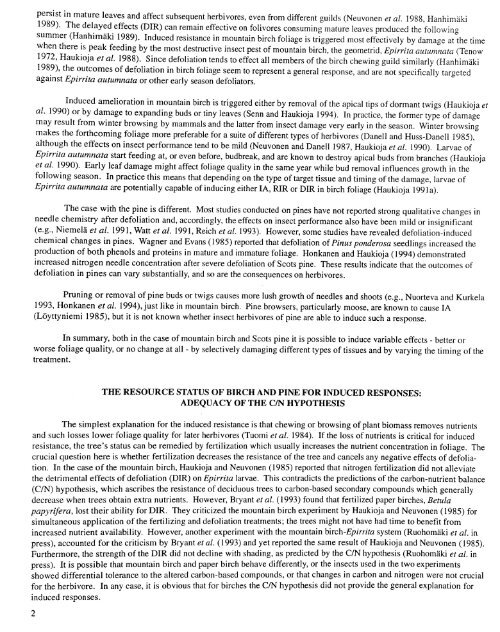View or print this publication - Northern Research Station - USDA ...
View or print this publication - Northern Research Station - USDA ...
View or print this publication - Northern Research Station - USDA ...
Create successful ePaper yourself
Turn your PDF publications into a flip-book with our unique Google optimized e-Paper software.
persist in mature leaves and affect subsequent herbiv<strong>or</strong>es, even from different guilds (Neuvonen et al. 1988, HanhimS.ki<br />
1989). The delayed effects (DIR) can remain effective on foliv<strong>or</strong>es consuming mature leaves produced the following<br />
summer (Hanhimfiki 1989). Induced resistance in mountain birch foliage is triggered most effectively by damage at the time<br />
when there is peak feeding by the most destructive insect pest of mountain birch, the geometrid, Epirrita autumnata (Tenow<br />
1972, Haukioja et al. 1988). Since defoliation tends to effect all members of the birch chewing guild similarly (Hanhim_iki<br />
1989), the outcomes of defoliation in birch foliage seem to represent a general response, and are not specifically targeted<br />
against Epirrita autumnata <strong>or</strong> other early season defoliat<strong>or</strong>s.<br />
Induced ameli<strong>or</strong>ation in mountain birch is triggered either by removal of the apical tips of d<strong>or</strong>mant twigs (Haukioja et<br />
al. 1990) <strong>or</strong> by damage to expanding buds <strong>or</strong> tiny leaves (Senn and Haukioja 1994). In practice, the f<strong>or</strong>mer type of damage<br />
may result from winter browsing by mammals and the latter from insect damage very early in the season. Winter browsing<br />
makes the f<strong>or</strong>thcoming foliage m<strong>or</strong>e preferable f<strong>or</strong> a suite of different types of herbiv<strong>or</strong>es (Danell and Huss-Danell 1985),<br />
although the effects on insect perf<strong>or</strong>mance tend to be mild (Neuvonen and Danell 1987, Haukioja et al. 1990). Larvae of<br />
Epirrita autumnata start feeding at, <strong>or</strong> even bef<strong>or</strong>e, budbreak, and are known to destroy apical buds from branches (Haukioja<br />
et al. 1990). Early leaf damage might affect foliage quality in the same year while bud removal influences growth in the<br />
following season. In practice <strong>this</strong> means that depending on the type of target tissue and timing of the damage, larvae of<br />
Epirrita autumnata are potentially capable of inducing either IA, RIR <strong>or</strong> DIR in birch foliage (Haukioja 1991a).<br />
The case with the pine is different. Most studies conducted on pines have not rep<strong>or</strong>ted strong qualitative changes in<br />
needle chemistry after defoliation and, acc<strong>or</strong>dingly, the effects on insect perf<strong>or</strong>mance also have been mild <strong>or</strong> insignificant<br />
(e.g., NiemelS. et al. 1991, Watt et al. 1991, Reich et al. 1993). However, some studies have revealed defoliation-induced<br />
chemical changes in pines. Wagner and Evans (1985) rep<strong>or</strong>ted that defoliation of Pinus ponderosa seedlings increased the<br />
production of both phenols and proteins in mature and immature foliage. Honkanen and Haukioja (1994) demonstrated<br />
increased nitrogen needle concentration after severe defoliation of Scots pine. These results indicate that the outcomes of<br />
defoliation in pines can vary substantially, and so are the consequences on herbiv<strong>or</strong>es.<br />
Pruning <strong>or</strong> removal of pine buds <strong>or</strong> twigs causes m<strong>or</strong>e lush growth of needles and shoots (e.g., Nu<strong>or</strong>teva and Kurkela<br />
1993, Honkanen et al. 1994), just like in mountain birch. Pine browsers, particularly moose, are known to cause IA<br />
(L6yttyniemi 1985), but it is not known whether insect herbiv<strong>or</strong>es of pine are able to induce such a response.<br />
In summary, both in the case of mountain birch and Scots pine it is possible to induce variable effects - better <strong>or</strong><br />
w<strong>or</strong>se foliage quality, <strong>or</strong> no change at all - by selectively damaging different types of tissues and by varying the timing of the<br />
treatment.<br />
THE RESOURCE STATUS OF BIRCH AND PINE FOR INDUCED RESPONSES:<br />
ADEQUACY OF THE C/N HYPOTHESIS<br />
The simplest explanation f<strong>or</strong> the induced resistance is that chewing <strong>or</strong> browsing of plant biomass removes nutrients<br />
and such losses lower foliage quality f<strong>or</strong> later herbiv<strong>or</strong>es (Tuomi et al. 1984). If the loss of nutrients is critical f<strong>or</strong> induced<br />
resistance, the tree's status can be remedied by fertilization which usually increases the nutrient concentration in foliage. The<br />
crucial question here is whether fertilization decreases the resistance of the tree and cancels any negative effects of defoliation.<br />
In the case of the mountain birch, Haukioja and Neuvonen (1985) rep<strong>or</strong>ted that nitrogen fertilization did not alleviate<br />
the detrimental effects of defoliation (DIR) on Epirrita larvae. This contradicts the predictions of the carbon-nutrient balance<br />
(C/N) hypothesis, which ascribes the resistance of deciduous trees to carbon-based secondary compounds which generally<br />
decrease when trees obtain extra nutrients. However, Bryant et al. (1993) found that fertilized paper birches, Betula<br />
papyrifera, lost their ability f<strong>or</strong> DIR. They criticized the mountain birch experiment by Haukioja and Neuvonen (1985) f<strong>or</strong><br />
simultaneous application of the fertilizing and defoliation treatments; the trees might not have had time to benefit from<br />
increased nutrient availability. However, another experiment with the mountain birch-Epirrita system (Ruohom_iki et al. in<br />
press), accounted f<strong>or</strong> the criticism by Bryant et al. (1993) and yet rep<strong>or</strong>ted the same result of Haukioja and Neuvonen (1985).<br />
Furtherm<strong>or</strong>e, the strength of the DIR did not decline with shading, as predicted by the C/N hypothesis (Ruohom_iki et al. in<br />
press). It is possible that mountain birch and paper birch behave differently, <strong>or</strong> the insects used in the two experiments<br />
showed differential tolerance to the altered carbon-based compounds, <strong>or</strong> that changes in carbon and nitrogen were not crucial<br />
f<strong>or</strong> the herbiv<strong>or</strong>e. In any case, it is obvious that f<strong>or</strong> birches the C/N hypothesis did not provide the general explanation f<strong>or</strong><br />
induced responses.<br />
2
















